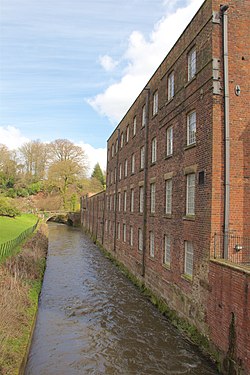Quarry Bank Mill
 |
|
| Owner | Samuel Greg |
|---|---|
| Further ownership |
|
| Coordinates | 53°20′38″N 2°14′58″W / 53.34390°N 2.24950°WCoordinates: 53°20′38″N 2°14′58″W / 53.34390°N 2.24950°W |
| Construction | |
| Built | 1784 |
| Renovated |
|
| Floor count | 5 |
| Power | |
| Date | 1796,1810 |
| Engine maker | Boulton & Watt |
| Water Power | |
| Diameter / width of water wheel | 32 feet (9.8 m) / 21 feet (6.4 m) |
Quarry Bank Mill in Styal, Cheshire, England, is one of the best preserved textile mills of the Industrial Revolution and is now a museum of the cotton industry. It is recorded in the National Heritage List for England as a designated Grade II* listed building, and inspired the 2013 television series The Mill.
Quarry Bank Mill is on the outskirts of Styal in Cheshire, abutting and to the south of Manchester Airport. The mill is on the bank of the River Bollin which provided water to power the waterwheels. It was connected by road to the Bridgewater Canal for transporting raw cotton from the port of Liverpool. The site consisted of three farms or folds.
Samuel Greg leased land at Quarrell Hole on Pownall Fee from Lord Stamford, who imposed a condition that 'none of the surrounding trees should be pruned, felled or lopped´; maintaining the woodland character of the area. The factory was built in 1784 by Greg to spin cotton. When Greg retired in 1832 it was the largest such business in the United Kingdom. The water-powered Georgian mill still produces cotton calico. The Gregs were careful and pragmatic, paternalistic millowners, and the mill was expanded and changed throughout its history. When Greg's son, Robert Hyde Greg, took over the business, he introduced weaving. Samuel Greg died in 1834.
The Mill was attacked during the Plug Plot riots on 10 August 1842.
The mill's iron water wheel, the fourth to be installed, was designed by Thomas Hewes and built between 1816 and 1820. Overhead shafts above the machines were attached to the water wheel by a belt. When the wheel turned, the motion moved the belt and powered the machinery. A beam engine and a horizontal steam engine were subsequently installed to supplement the power. The Hewes wheel broke in 1904 but the River Bollin continued to power the mill through two water turbines. The mill owners bought a Boulton and Watt steam engine in 1810 and a few years later purchased another because the river's water level was low in summer and could interrupt production of cloth during some years. Steam engines could produce power all year round. Today the mill houses the most powerful working waterwheel in Europe, an iron wheel moved from Glasshouses Mill at Pateley Bridge designed by Sir William Fairbairn who had been Hewes' apprentice.
...
Wikipedia
